Opinion
Kenny Schachter on the Old Guard, the Upstarts, and Getting Naked at Art Cologne
The oldest contemporary art fair still packs surprises.
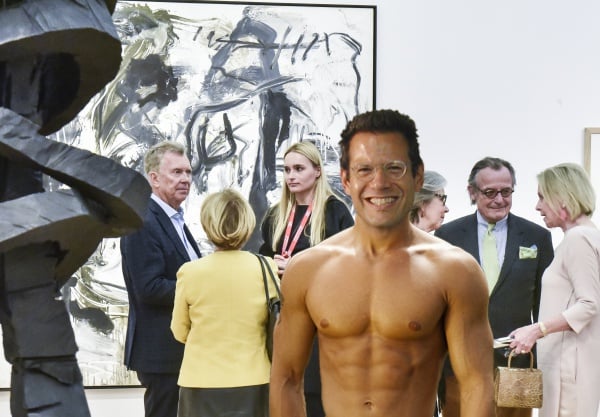
The oldest contemporary art fair still packs surprises.

Kenny Schachter

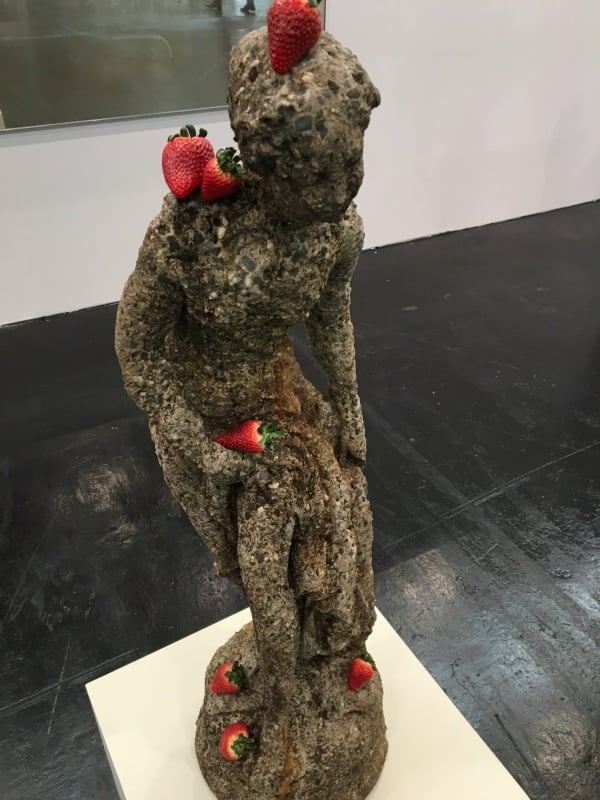
Tony Matelli at Marlborough.
Image: Courtesy of Kenny Schachter.
If It’s Tuesday, This Must Be Cologne
If It’s Tuesday, This Must Be Belgium was a rollicking 1969 comedy (with Suzanne Pleshette), featuring a busload of Americans touring Europe. The art world equivalent is an ever expanding, never-ending roster of art fair ports of call, but far less humorous (though I obviously have a penchant for them). Speaking of Belgium, Art Brussels opens April 21 (and to the public on April 22) in a location NEW! IMPROVED! Fear not, I’ll take a pass.
At 50, Art Cologne is the oldest contemporary art fair (the oldest of those that also feature a modern component) but long ago left behind by tectonic art market shifts well beyond its control. A repeated refrain I encountered wending my way down the aisles this iteration was: “Why are you here?” Maybe because it’s a fucking art fair and I’ve been attending and writing about them for 25 years; how’s that for starters?
I also happened to have served on the selection committee of Cologne from 2006-2008, though having been thrown out of nearly as many fairs as I’ve participated in, I was as surprised as any to have been selected. And, beginning with my first curatorial effort, German Paper in 1990 at New York’s Sandra Gering Gallery, to my last, polke/richter richter/polke at Christie’s Mayfair, London in 2014, I’ve always loved German art.
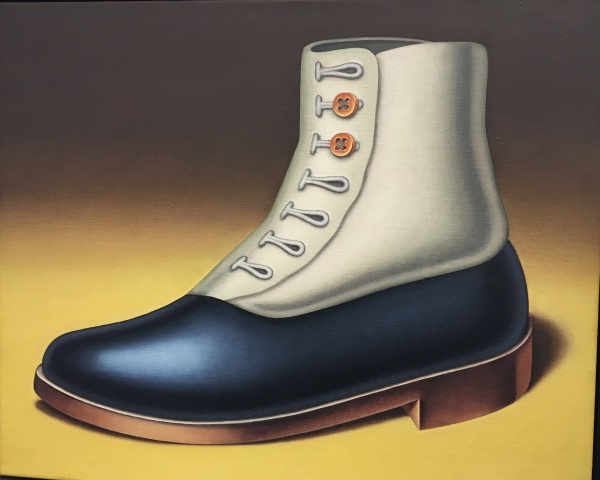
Konrad Klapheck at Galerie Michael Haas.
Image: Courtesy of Kenny Schachter.
If there’s ever a perch from which to firsthand observe the politics and capriciousness of the art world, a selection committee is just such a place. And in Germany, galleries have a statutory right to sue for cause if they aren’t accepted. So you doubly have your work cut out when you serve in this capacity. What was intended as a three-year stint was unceremoniously cut short by a not-very-attractive coup that played out in the public press in a way not seen before (or to be repeated). Local gallerists banded together to unseat Gerard Goodrow, the director of the fair at the time, via a newspaper advertisement decrying the loss of status of the fair; but no matter how hard you yearn, you can’t will a market back to life. They dethroned Goodrow in 2008 and replaced him with former gallery owner Daniel Hug, the grandson of the Bauhaus artist László Moholy-Nagy.
Since the 2008 obituary I wrote on the fair, it was that desolate, things have improved considerably and it’s firmly back on its feet. But the prestige is gone. It’s not as bad as it sounds; Basel Hong Kong is also a regional fair that is thriving, awash in the support of local buyers and similar to Hong Kong, at Art Cologne there are not the omnipresent clicks of New York advisors stumbling over themselves. Unlike Hong Kong, and a factor that’s the greatest draw for me, is the distinctly German flair to the fair fare.
When I attended back in 2009 (I never miss it), Hug literally accosted me about my rabid critical stance. But I just report what I see. For the first time since then, I even got a VIP pass this go round. Though the opening flaunted strong crowds, I didn’t stay long enough to form a concrete sense of sales. Art Cologne is not the kind of event to rush home and write about in a frenzied all night-er to get the info online in a flash of breaking news. It’s a slow burner, which I’ve always particularly liked about it. Oh, and maybe it will end up in the Basel portfolio, swallowed by its progeny.
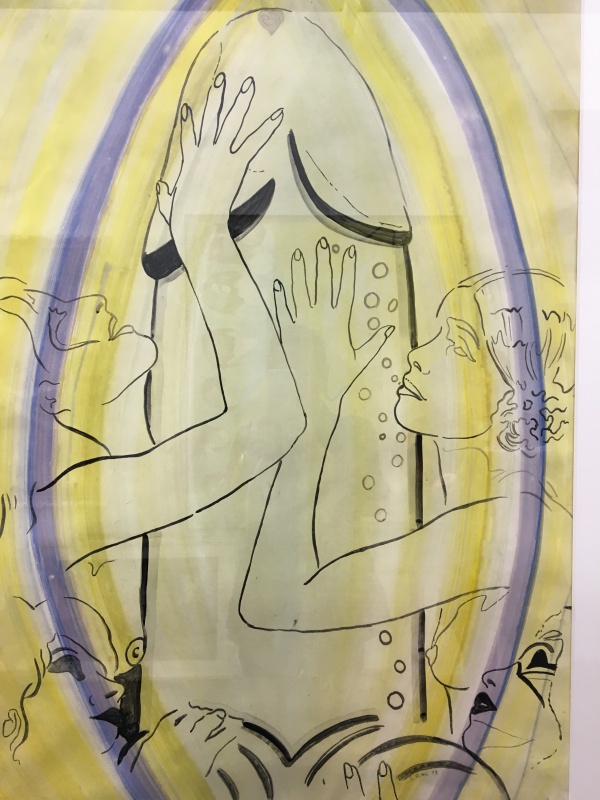
Sigmar Polke at Michael Werner.
Image: Courtesy of Kenny Schachter.
The Old Guard and the Upstarts
The geo-political-economic layout (fair hierarchy is never anything less) is broken down into three generous floors from the youngest on top (well, sort of) to the oldest on the bottom, I guess it’s easier to go down half a flight than up a further two; Teutonic pragmatism is never far from the fold.
Smack in the middle of the middle floor are the power players of Art Cologne’s mix: the old guard, professorial, always elegant Karsten Greve, and the rest—relative upstarts David Zwirner, Hauser & Wirth, Thaddaeus Ropac, and Sprueth Magers. Gagosian’s absence in an art fair is like a missing front tooth; such is the enormity of his gallery’s energy and (price) presence.
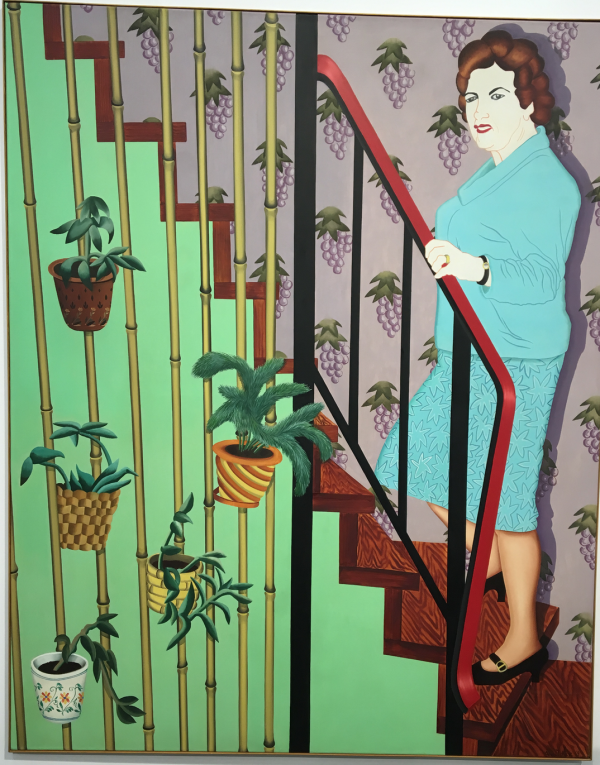
The locals that don’t generally make it to the circuit (in such magnitude, anyway) include 81-year-old Konrad Klapheck—who sold a cropped shoe as if lifted from Manet’s Fifer, for €160,000; 72-year-old Almut Heise; 76-year-old Imi Knobel and this year’s (attempted) breakout—if the amount of works and booth exposure is any measure—Gotthard Graubner (1930-2013). Polke (1941-2010) paper works also proliferated, from €20,000 for a fairly great work to about €350,000.
Almut had a large, 1969 proto-Pop canvas, a sardonic version of Christian Schad (1894-1982), from Upper Bavaria another native. For €80,000, there’s pause for thought, however brief, yet her new works come up short by comparison, losing vitality in a more photo-generic, less cartoonish style. Then there was Gotthard Graubner who seemed to permeate every floor; with an auction record of $341,000 back in 2010, per the artnet Price Database, and a respectable 631 lots having sold over the years, you have an artist ripe for reassessment, a veritable fad today. Or overkill. Formally pleasing (sort of), bland and easy on the eye, they look like painted stuffed mattresses resembling a cross between the Zeroes and Zombies, from Enrico Castellani and Agostino Bonalumi to Kaari Upson to Justin Adian.
The potpourri of Graubner pieces (and prices) ranged from big ones at Karsten Greve for €350,000 – 450,000, smaller ones for €180; at Galerie Schwarzer, they were €320,000 for large sized works; Galerie Ludorff tagged their more compact painting at €250,000 and then there was Walter Storms with yet another small work for €90,000. I felt like lying down on a mattress after taking in the dizzying array.
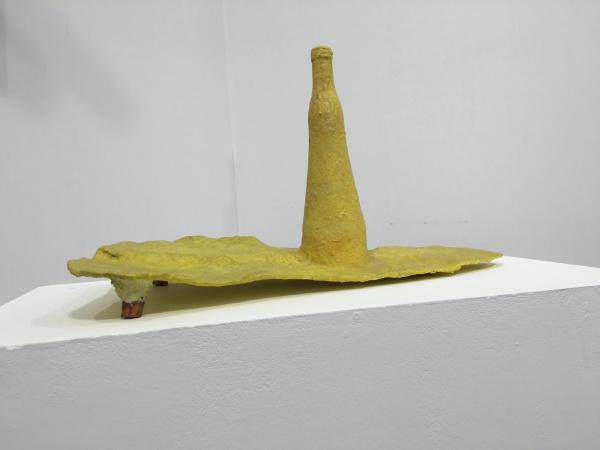
Franz West at Galerie Konzett.
Image: Courtesy of Kenny Schachter.
Michael Werner seemed to be flushing out storage after his long association with Sigmar Polke came to an abrupt end when he lost out to David Zwirner, which was recently appointed to represent the estate. There was a dearth of Polke canvases throughout; the market is in a state of repose with the big guns about to be rolled out next month when Zwirner makes its first foray into showing the artist.
Values being what they are, only teeny-tiny Richters of no note were on view as the market settles into the 1,000 percent run-up over the past five years or so. Art Cologne is not the place for this material. Though the market frenzy has died, there’s always the other Richter, Daniel, who’s still at it with a psychedelic canvas referencing Munch on MDMA, available at €125,000.
Franz West is Germany’s Giacometti with flesh, albeit downright sloppy by comparison, but still. West sculptures range from about €45,000 for a limited edition lamp, €65,000 for a painting on paper, and €220,000 for decent-sized objects. But at times, it can fluctuate wildly—up to to $1 million—like when the aforementioned Mr. Zwirner steps in.
Galerie Konzett is a wonderful, low-key space from Austria, West’s birthplace, who has personally handled more than 1,500 of the artist’s pieces over more than three decades. Where else can you discover this? Why Konzett was on the lower ground floor with modern art is unclear; maybe it will portend good things to come for the gallery, West and his market.
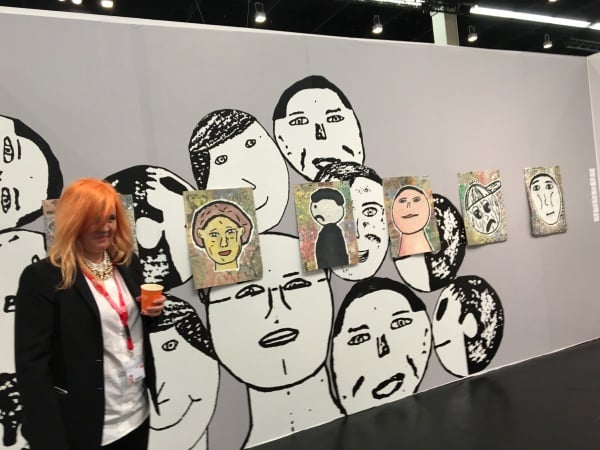
The Hole’s stand.
Image: Courtesy of Kenny Schachter.
The Collaborations
Three years ago visiting the fair, I unexpectedly landed at the New Art Dealers Alliance (NADA), which was programmed like a virus, a(n ancillary) fair within a fair, quite a cool conceptual conceit. Sadly, the innovative idea to literally suck in the identity of another branded event was like an onion with commercial and not-for-profit mind sets layered over each other. But alas, it was only a short-lived initiative; the new NADA has been shorn of its identity, and billed as “Collaborations” subsumed back under the rubric of the main tent. Collaborations, whether with artists or galleries, are usually defined by the lesser of their constituent components when combined.
To muddle things further, there was another section entitled “New Contemporaries.” To cut to the chase, these are subsidized booths that pay half the nut but are given this reduced rate because their presence enhances the flavor of the proceedings, like MSG. Either way you slice it, it’s the floor where it’s most tricky to separate wheat and chaff with more artists from more countries than ever in history.
An example of a NADA collaboration was Donald Baechler, Misaki Kawai, and Taylor McKimmons at the booth of Kathy Grayson’s fabulous gallery the Hole. Baechler made the wallpaper that his small drawings (€9,000 each) hung on. Wow. His early work is criminally underappreciated, but this was a stretch. And his new canvases are regularly cheaper at auction. The idea of presenting the three artists in this joint effort came off as weak and forced. No one likes collaborations; art is very much an individual pursuit.
Inexplicably, sandwiched between the Collaborations and New Contemporaries was Tony Matelli, who I collect, at Marlborough. But what kind of cutting edge contemporary art is this? His works were €13,000 for dust paintings and up to €60,000 for sculptures. The gratuitous demarcations were baffling; you can imagine a shopping alert ringing overhead directing fairgoers to visit certain highlights.
NADA bills itself as “the definitive non-profit arts organization dedicated to the cultivation, support, and advancement of new voices in contemporary art.” A tall order, that, and how Donald Baechler or Tony Matelli quite fits the bill is anybody’s guess. God knows NADA’s re-amalgamation in fairs to come, they are a not-for-profit whipping post.
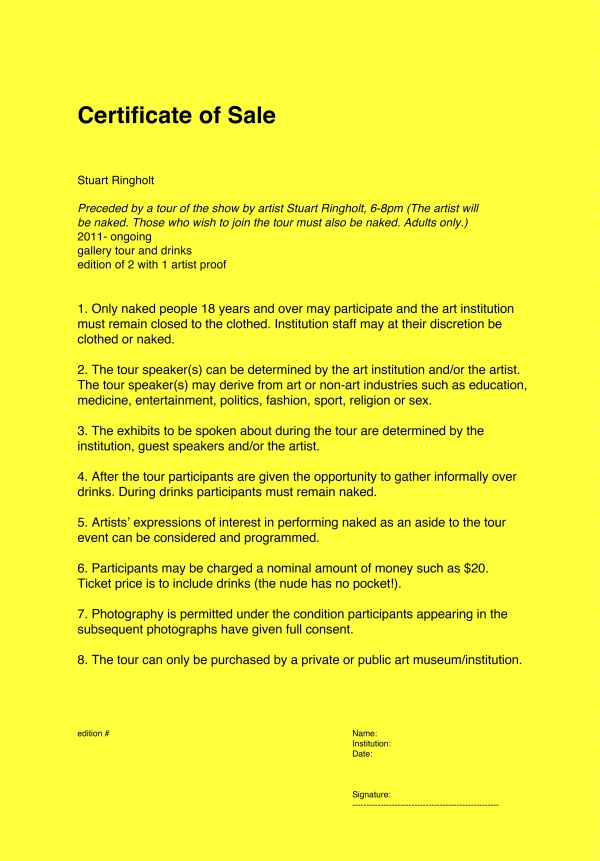
Certificate of Sale for Stuart Ringholt’s naked tour.
Image: Courtesy of Kenny Schachter.
Nude Incentives
I was asked to cover a performance on the official program by Stuart Ringholt born in Perth, represented at the fair by Neon Parc of Melbourne, not previously on the radar as a hotbed for relational aesthetics, which is what the work smacked of: a guided tour of selected artworks in the fair, with docent and participants alike, naked. Luckily, I had to prematurely evacuate (so to speak)—I don’t get undressed alone. I’ve had nightmares as a child of being on the school bus before discovering in horror that I was in a state of partial undress; Spencer Tunick’s mass of ass holds no titillation.
Following a trail of crummy cars all bearing vanity plates that read CURATOR in one shape or another, strewn from outside the entrance of the fair right up to the third floor—I’m a sucker for art with cars, even when unfit for a demolition derby—and ending with the naked artist. Like the performance, the installation was also sanctioned by Art Cologne. After getting roped into meeting him by his zealous, punching above his weight gallerist (who was quite likeable), I ended up talking to Ringholt too, and his work. Trust me, meeting emerging artists at this stage of my life (after decades of doing so), from Australia no less, when I have to admit to preferring mostly artist estates, is not stress-free.
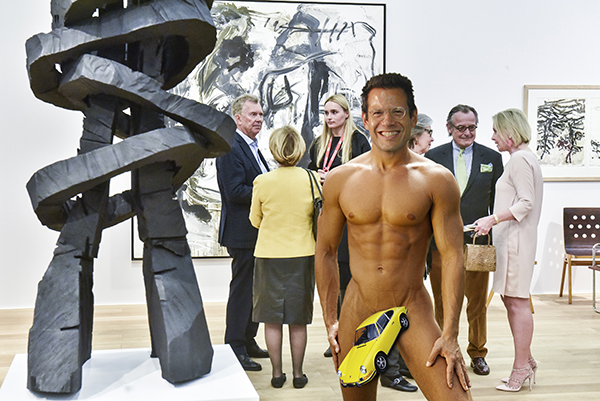
Collage by Kenny Schachter.
Image: Courtesy of Kenny Schachter
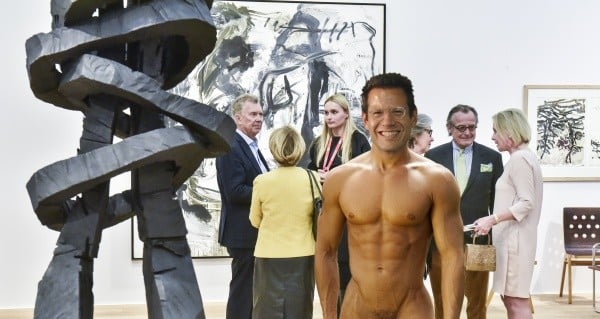
Collage by Kenny Schachter.
Image: Courtesy of Kenny Schachter.
Other works by Ringholt had the artist publicly acting out self-inflicted embarrassing situations (I do that with every column) and conducting anger management classes, where one woman became overcome by a Tourette’s-like trance and repeatedly shouted out the word cunt. Sign me up for that social sculpture—I can relate to all things other than bareness.
Before I had to run for my plane (handily), Daniel Hug passed by who I asked if he’d be going full frontal to which he replied he looked good naked having lost weight but was preoccupied (yeah, I bet).
Passing by New York’s Canada Gallery I overheard the irascible proprietor Phil Grauer pleading to bribe the Don and Mera Rubell with $20 (or was it euro?) to see his wife’s exhibit about to close in the gallery. As I leaned into the convo, Don tried to forewarn Mera not to respond in front of me but it was too late—she had already accepted the offer. How could you not fall deeply for the intrepid Rubells? By the way, in the 25 years that I’ve known them, not a $1 has ever changed hands between us, not for lack of trying.

“There was a trail of crummy cars all bearing vanity plates that read CURATOR in one shape or another, strewn from outside the entrance of the fair right up to the third floor.”
Image: Courtesy of Kenny Schachter.
I tuned in to CNN on my return home and happened upon a segment on F1 Champion Lewis Hamilton making his way through Art Basel Miami (perfect backdrop) explicating his love of “real depth” in painting, which was about as deep as the puddles he avoids on a wet racetrack. Granted, Art Cologne wasn’t a shambolic, rip-roaring rampage, drenched in celebrity claptrap, cash, and conspiracy (as May in New York will be—stay tuned), but therein lies its merits.
Cologne is an old school 60-watt bulb, too dim to draw in the big bucks of the Basels despite endless efforts to reclaim the faded former glory that, at this stage, is hard to fathom it once had. I tell you it’s a relief to be in a commercial context entirely more focused on the art rather than the surrounding hullabaloo—like just about every fair other than the Basel-Basel. This is largely a place for connoisseurs to look rather than listen. As another artist from the area, Arnold Schwarzenegger, put it in the 1984 film The Terminator: I’ll be back.